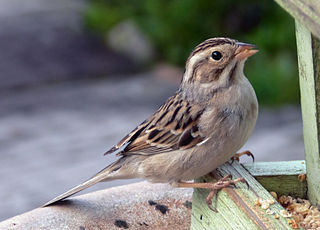
The clay-colored sparrow or clay-coloured sparrow is a small New World sparrow of North America.
The green-backed eremomela is a member of the Cisticolidae. This bird is a common resident breeder in tropical Africa from Kenya and Ethiopia to Cameroon.

The lilac-breasted roller is an African bird of the roller family, Coraciidae. It is widely distributed in Southern and Eastern Africa, and is a vagrant to the southern Arabian Peninsula. It prefers open woodland and savanna, and it is for the most part absent from treeless places. Usually found alone or in pairs, it perches at the tops of trees, poles or other high vantage points from where it can spot insects, amphibians and small birds moving about on the ground. Nesting takes place in a natural hole in a tree where a clutch of 2–4 eggs are laid, and incubated by both parents, who are extremely aggressive in defence of their nest, taking on raptors and other birds. During the breeding season the male will rise to a fair height, descending in swoops and dives, while uttering harsh, discordant cries. The sexes do not differ in coloration, and juveniles lack the long tail streamers of adults. This species is unofficially considered the national bird of Kenya. Alternative names for the lilac-breasted roller include the fork-tailed roller, lilac-throated roller and Mosilikatze's roller.

The Cape sparrow, or mossie, is a bird of the sparrow family Passeridae found in southern Africa. A medium-sized sparrow at 14–16 centimetres (5.5–6.3 in), it has distinctive plumage, including large pale head stripes in both sexes. Its plumage is mostly grey, brown, and chestnut, and the male has some bold black and white markings on its head and neck. The species inhabits semi-arid savannah, cultivated areas, and towns, and ranges from the central coast of Angola to eastern South Africa and Eswatini. Three subspecies are distinguished in different parts of its range.

The russet sparrow, also called the cinnamon or cinnamon tree sparrow, is a passerine bird of the sparrow family Passeridae. A chunky little seed-eating bird with a thick bill, it has a body length of 14 to 15 cm (5.5–5.9 in). Its plumage is mainly warm rufous above and grey below. It exhibits sexual dimorphism, with the plumage of both sexes patterned similarly to that of the corresponding sex of house sparrow. Its vocalisations are sweet and musical chirps, which when strung together form a song.
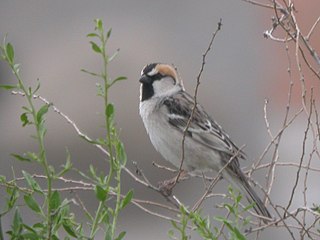
The saxaul sparrow is a passerine bird of the sparrow family Passeridae, found in parts of Central Asia. At 14–16 centimetres (5.5–6.3 in) and 25–32 grams (0.88–1.13 oz), it is among the larger sparrows. Both sexes have plumage ranging from dull grey to sandy brown, and pale brown legs. Females have less boldly coloured plumage and bills, lacking the pattern of black stripes on the male's head. The head markings of both sexes make the saxaul sparrow distinctive, and unlikely to be confused with any other bird. Vocalisations include a comparatively soft and musical chirping call, a song, and a flight call.

The white-tailed mongoose is a species in the mongoose family Herpestidae. It is the only member of the genus Ichneumia.

The white-eared ground sparrow is a large American sparrow which occurs locally in Middle America, mostly in foothills, from southern Mexico and Guatemala to northern Costa Rica.

The black-winged lovebird also known as Abyssinian lovebird is a mainly green bird of the parrot family. At about 16.5 cm (6.5 inches) long, it is the largest of the lovebird genus, a group of small parrots. The adult male is easily identified by its red forehead, and the adult female by its all-green head. They are native to Eritrea and Ethiopia, and they are uncommon as pets.

The wattled starling is a nomadic resident bird in eastern and southern Africa. It is a species of grassland, open woodland, and cultivation.
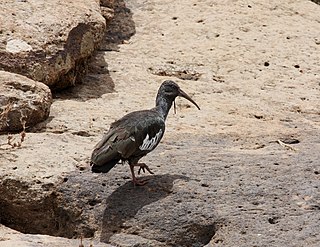
The wattled ibis is a species of bird in the family Threskiornithidae. It is endemic to the Ethiopian highlands and is found only in Ethiopia and Eritrea.

The white-collared pigeon is a species of bird in the family Columbidae.
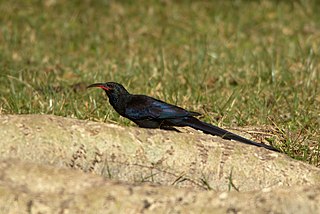
The black-billed wood hoopoe is a species of bird in the family Phoeniculidae. It is native to eastern Africa where it is found in wooded and scrubby areas.

The Tumbes sparrow is a species of bird in the family Passerellidae found in Ecuador and Peru. Its natural habitats are subtropical or tropical dry forests and subtropical or tropical dry shrubland.

The grey-headed batis is a species of bird in the wattle-eyes family, Platysteiridae, it was previously classified with the Old World flycatchers in the family Muscicapidae. It is found in eastern and central Africa.

The little rock thrush is a passerine bird in the family Muscicapidae. It is found in Eritrea, Ethiopia, Kenya, Oman, Saudi Arabia, Somalia, South Sudan, Tanzania, Uganda, and Yemen. It is found in rocky areas with some trees, and sometimes near settlements. At 15 to 16 centimetres this is the smallest of the Muscicapidae. The male has the head, throat and upper mantle blue-grey, the underparts orange-red, except for the center blackish center tail and tips which form an inverted T shape. The female is duller and paler. It is readily mistaken for a redstart because of its habit of trembling its tail.

The chestnut-crowned sparrow-weaver is a species of bird in the family Ploceidae.

The baglafecht weaver is a species of weaver bird from the family Ploceidae which is found in eastern and central Africa. There are several disjunct populations with distinguishable plumage patterns. Only some races display a discrete non-breeding plumage.

Rüppell's weaver is a species of bird in the family Ploceidae, which is native to the northern Afrotropics. The species is named after the German zoologist and explorer Eduard Rüppell (1794–1884).
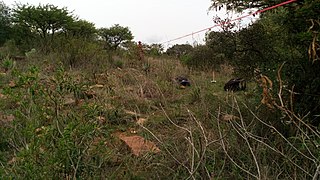
Addilal is an exclosure located in the Dogu'a Tembien woreda of the Tigray Region in Ethiopia. The area has been protected since 1992 by the local community.





















